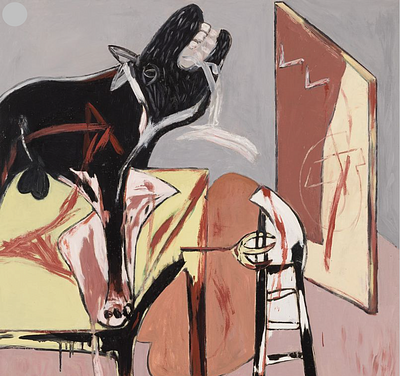CELSO LAGAR ARROYO (Ciudad Rodrigo, León, 1891 - Seville, 1966). "Female nude". Oil on canvas.
Lot 96
About Seller
Setdart Auction House
Carrer Aragó 346
Barcelona
Spain
Setdart Subastas was born in 2004 and is currently the first online art auction in Spain with solidity, prestige and reliability guaranteed by our more than 60,000 users. Setdart has a young, dynamic and enterprising team ready to successfully manage the purchase and sale of art works through custom...Read more
Categories
Estimate:
EUR€8,000 - EUR€9,000
$8,602.15 - $9,677.42
Absentee vs Live bid
Two ways to bid:
- Leave a max absentee bid and the platform will bid on your behalf up to your maximum bid during the live auction.
- Bid live during the auction and your bids will be submitted real-time to the auctioneer.
Bid Increments
| Price | Bid Increment |
|---|---|
| EUR€0 | EUR€10 |
| EUR€200 | EUR€25 |
| EUR€500 | EUR€50 |
| EUR€1,000 | EUR€100 |
| EUR€3,000 | EUR€200 |
| EUR€5,000 | EUR€500 |
| EUR€10,000 | EUR€1,000 |
| EUR€20,000 | EUR€2,000 |
| EUR€50,000 | EUR€5,000 |
About Auction
By Setdart Auction House
Nov 16, 2021
Set Reminder
2021-11-16 08:00:00
2021-11-16 08:00:00
America/New_York
Bidsquare
Bidsquare : Contemporary and Actual Art
https://www.bidsquare.com/auctions/setdart-auction-house/contemporary-and-actual-art-7839
Setdart Auction House sofia@setdart.com
Setdart Auction House sofia@setdart.com
- Lot Description
CELSO LAGAR ARROYO (Ciudad Rodrigo, León, 1891 - Seville, 1966). "Female nude". Oil on canvas. Signed in the upper right corner. Attached certificate issued by the Lagar Archive. Measurements: 68 x 50 cm; 78 x 60 cm (frame). Celso Lagar offers us in this canvas a female nude captured from life. For it he uses an energetic language that seeks above all to capture the volumetry and the geometric game, although he maintains descriptive details that avoid the loss of realism. The woman shows the viewer practically her entire naked body, since only the lower part of her legs remains outside the perimeter of the support. Celso Lagar began his training in the field of sculpture with Miguel Blay in Madrid. His teacher advised him to travel to Paris to complete his studies and, after spending a year in Barcelona, he traveled to the French capital for the first time in 1911. Lagar's career, both personally and artistically, can be divided into four distinct stages, marked by the two World Wars. The first of these periods is that of apprenticeship, in Madrid, Barcelona and Paris, in contact with artists such as Amadeo Modigliani. This stage comes to an end when he is forced to leave Paris at the outbreak of the Great War. He settled in Barcelona but held several exhibitions in the French capital, which served as a letter of introduction upon his return to the city after the war, in 1919. By then Lagar is already a consolidated artist, and settles definitively in Paris. He regularly exhibited in the best Parisian galleries (Berthe Weil, Percier, Zborowski, Barreiro, Brouant, Druet), his style reached its personal maturity and he devoted himself fully to painting, leaving sculpture behind. He developed a painting focused on very specific themes: still lifes, Spanish themes, landscapes and circus scenes. After the period of avant-garde influences (cubist, fauvist, etc.), Lagar reached his own style, marked by the influences of Goya and Picasso. Gradually his palette cools down, but his favorite themes remain the same, and his recognition by the public and critics increases. The beginning of World War II marked the end of Lagar's golden age. He emigrated to the French Pyrenees, and his return to the recently liberated city of Paris did not have the repercussions he had hoped for, as the collecting public demanded new contents and modes. After his wife fell ill in 1956, Lagar fell into a deep depression and was admitted to a psychiatric center. He definitively stopped painting and in 1964 he returned to Spain, spending his last years at his sister's house in Seville. Lagar is represented in the Museum of Contemporary Art in Madrid, the Museum of Art Nouveau and Art Deco Casa Lis, the Patio Herreriano in Valladolid, the Petit Palais in Geneva, the Fine Arts of La Rochelle, Castres and Honfleur (France) and in prestigious collections such as Crane Kallman (London), the Zborowski (Paris) or the Mapfre (Madrid).
- Shipping Info
-
In-house shipping available. Please inquire at admin@setdart.com.
-
- Buyer's Premium



 EUR
EUR CAD
CAD AUD
AUD GBP
GBP MXN
MXN HKD
HKD CNY
CNY MYR
MYR SEK
SEK SGD
SGD CHF
CHF THB
THB















